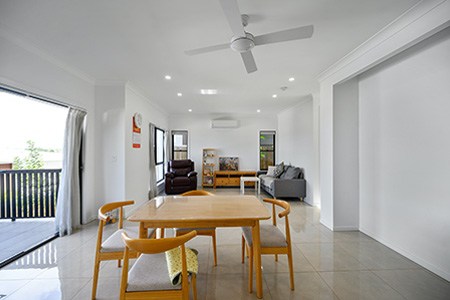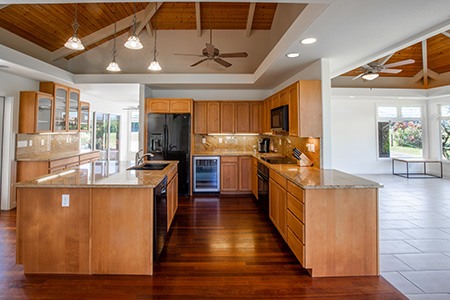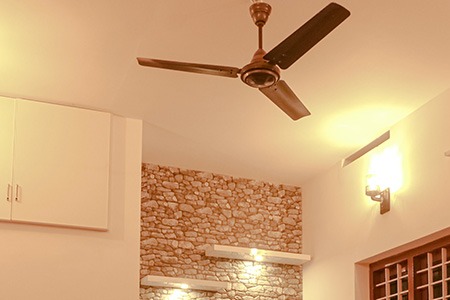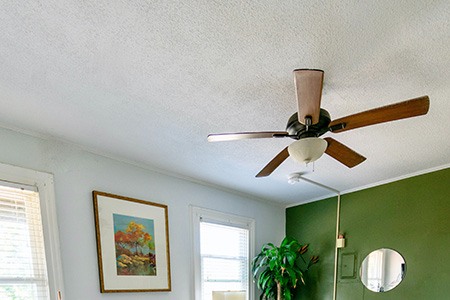Should You Install a Ceiling Fan in the Kitchen?
Author: Rick Worst | Editor: Omar Alonso
Review & Research: Jen Worst & Chris Miller

Ceiling fans have long been a popular choice for cooling off the home, but are they suitable for the kitchen? Let's explore the benefits of installing a ceiling fan in the kitchen to help you make an informed decision.
We'll look at factors like ceiling fan type, energy ratings, and space considerations to determine whether adding a ceiling fan to your kitchen is righft for you.
Pros of Putting a Ceiling Fan in the Kitchen

Can you put a ceiling fan in the kitchen? Adding a ceiling fan to the kitchen can be a great way to improve comfort and functionality.
Here are some advantages of installing a ceiling fan in the kitchen. It's no more weird than having a kitchen without windows and it's something that can be added to greatly improve your kitchen experience.
Saves Energy
One of the key advantages of putting a ceiling fan in the kitchen is that it can help save energy. During warm weather, you can use the ceiling fan to keep your kitchen cool without frequently turning on the air conditioner.
Saves Money
The energy saved by using the fan instead of the air conditioner will ultimately lead to lower electricity costs. Additionally, ceiling fans are less expensive than other cooling systems and can be installed relatively quickly without hiring a professional.
When used correctly, ceiling fans can help extend the life of your air conditioning system by helping to distribute cooled air throughout the room evenly. A kitchen with a ceiling fan will more easily disperse the hot air from your cooking activities, and will help tremendously if your thermostat is in the same room.
Gets Rid of Pests
The constant airflow created by the ceiling fan can help disrupt the habitat of certain insects, such as mosquitos and flies, making it difficult for them to establish themselves in your kitchen. This can lead to fewer insect-related problems and provide a more pest-free environment.
In addition, air circulation from a ceiling fan helps reduce moisture build-up, which can be especially beneficial in keeping away cockroaches and other pests.
Helps Eliminate Odors
The air circulation created by a fan helps keep the air fresh and prevents unpleasant odors from becoming trapped in the room. This is especially beneficial for those who do a lot of cooking and want to avoid having their kitchen smell like the meals they prepare.
Cooling down hot and humid air with a ceiling fan can also help reduce the impact of pungent food smells, allowing you to enjoy your kitchen without any unpleasant aromas.
Is a Ceiling Fan in the Kitchen a Good Idea?

We’ve already discussed the benefits of having a ceiling fan in the kitchen, but is it always the best choice? Here are some things that might influence your decision in installing these types of fans in the kitchen instead of a ceiling fan alternative.
Finding the Right Fan
When selecting a ceiling fan for your kitchen, there are several factors to consider:
- Consider the size and layout of the space. You'll want a large enough fan to move air throughout the room but not so big that it takes up too much space or throws off the room's balance.
- Consider the style and design of the fan. There are many different options available on the market, ranging from modern to traditional, so choose one that best fits your existing decor.
- Make sure you select a fan that has plenty of speed settings so you can customize its performance to suit your needs.
With some research and consideration, you can find the perfect ceiling fan for your kitchen.
Make Sure the Blades are Balanced
Balancing the blades on your ceiling fan can reduce wear and tear on the motor. Balanced blades will increase the fan's efficiency by ensuring it operates at its highest level of performance with smooth air circulation.
Follow the manufacturer's instructions to ensure that your ceiling fan blades are properly balanced. Use a fan balancing kit to adjust each blade's angles until each edge is perfectly aligned.
Taking the time to ensure each blade is correctly balanced will give you optimal performance and help extend the life of your fan. Otherwise you'll hear your ceiling fan clicking and rocking back and forth, making other noises as well.
Changing the Air Flow
Changing the airflow on a ceiling fan is a great way to maximize energy efficiency and keep your home comfortable in winter and summer. In the winter, you should switch your fan to rotate clockwise to pull cool air up from the floor. This will help make the room feel warmer and push heated air back into the living space.
During the summer months, switch your fan to a counterclockwise rotation to create a cooling breeze by pulling warm air up from the living area. By making this simple change in direction, you can optimize your fan's performance while saving money on your energy costs all year round.
Different Kinds of Kitchen Ceiling Fans

There are various types of ceiling fans for your kitchen to choose from, so it's essential to research and find the ceiling fan that best suits your needs. From blade size to motor type, there is a ceiling fan for every room and design preference. But these types of fans come with a lot of options. Let's explore those.
Length of Blades
Ceiling fans come in various sizes, with blade length being one of the more important characteristics to consider, especially for a ceiling fan in the kitchen. Longer blades create more airflow, which is excellent for larger rooms.
Shorter blades are perfect for bedrooms and other areas with limited space. You can also find ceiling fans with adjustable blade lengths to choose the size of blades that best suits your needs.
Number of Blades
The number of fan blades is another consideration when shopping for a ceiling fan. Many fans come in two-blade and three-blade options, but you can also find four- and five-blade models depending on your needs.
Each additional blade provides more air circulation at a lower speed, so if noise is a priority, you can opt for a fan with fewer blades. Additionally, the number of blades affects the appearance of the fan, so consider both function and design before making a purchase.
With Light or Without

Many ceiling fans come with integrated lighting fixtures, making them an excellent choice for rooms that require additional illumination. These fans often feature halogen or LED bulbs giving you the option of warm or cool light depending on your preference.
Some models also come with multiple bulb sockets, so you can adjust the brightness level in a room as needed.
Types of Controls
Ceiling fans come with various control types, so you can choose the one that best suits your needs. Some ceiling fans offer manual pull chains to switch the fan on and off, while others feature wall-mounted controls or remotes for convenience.
Many modern ceiling fans are now available with "smart" features such as Wi-Fi-enabled operation so you can control them from your smartphone or tablet. Additionally, some models have integrated dimmer controls to give you more control over the light level in the room.
DC or AC Motor
Ceiling fans that utilize a DC motor tend to be more energy-efficient than those with an AC motor, as the former often uses less power and operates at lower speeds.
DC motors can run at multiple speeds, while AC motors typically have a single-speed setting. Additionally, some DC motor ceiling fans even have reverse direction settings so you can adjust the airflow according to your needs.
Things to Consider About Ceiling Fans

When shopping for a ceiling fan, there are many important factors to consider. Here is what to keep in mind:
- Check airflow ratings. A higher rating means it circulates air more effectively.
- Make sure the fan is the right size. A fan that's too big will create too much noise and airflow.
- Check the Energy Star rating. Fans with this label are 60% more energy-efficient than regular fans.
- Make sure your fan will be accessible in your space. You'll want to be able to reach the top of the blades for cleaning while making sure no one can bump their head on it.
Think of these items as a Ceiling Fan 101 style of basics to make sure you cover, otherwise you can end up dissatisfied with your installation and think it’s the fan itself to blame. A ceiling fan in a small kitchen, should be smaller, for example, pushing a lesser volume of air.
Ceiling Fans in the Kitchen Can Be Great
Installing a ceiling fan in your kitchen is a great way to make this common space more energy efficient and enjoyable. With the right type of fan, you can add style and comfort to any kitchen while also helping to reduce energy consumption.
Whatever type of fan you choose, having a ceiling fan in the kitchen might be a good idea for anyone looking for an accessible space makeover that helps save energy, money, and more.



